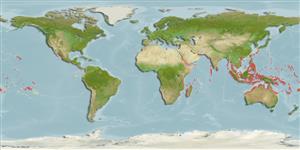Environment: milieu / climate zone / depth range / distribution range
Ecología
marino asociado a arrecife; rango de profundidad 0 - 3 m (Ref. 30874). Tropical; 32°N - 28°S
Indo-Pacific: Laccadive Islands and Maldives to Mangaréva, Gambier Islands. Western Central Pacific: Guam (Ref. 35721).
Tamaño / Peso / Age
Maturity: Lm ? range ? - ? cm
Max length : 15.0 cm TL macho / no sexado; (Ref. 48636)
Short description
Claves de identificación | Morfología | Morfometría
Espinas dorsales (total) : 13 - 14; Radios blandos dorsales (total) : 22 - 25; Espinas anales: 2; Radios blandos anales: 23 - 25. Color dusky, greenish with dusky lines. Males with crest and dorsal with alternate dark and pale oblique lines (Ref. 48636). Living specimens may exhibit a complex facial pattern similar to, but not quite as intricate as, that of Entomacrodus niuafoouensis, and barely discernable parallel pinstripes on their sides.
Facultative air-breathing (Ref. 126274); Adults occur in the intertidal zone of rocky shores, rocky reef flats (Ref. 9710), including rock pools, harbors and mangrove zones (Ref. 48636). They graze algae on rocks by groups (Ref. 90102). Oviparous. Eggs are demersal and adhesive (Ref. 205), and are attached to the substrate via a filamentous, adhesive pad or pedestal (Ref. 94114). Larvae are planktonic, often found in shallow, coastal waters (Ref. 94114).
Life cycle and mating behavior
Madurez | Reproducción | Puesta | Huevos | Fecundidad | Larva
Oviparous, distinct pairing (Ref. 205).
Springer, V.G. and J.T. Williams, 1994. The Indo-West Pacific blenniid fish genus Istiblennius reappraised: a revision of Istiblennius, Blenniella, and Paralticus, new genus. Smithson. Contrib. Zool. 565:1-193. (Ref. 9962)
IUCN Red List Status (Ref. 130435: Version 2024-2)
Threat to humans
Harmless
Human uses
Pesquerías: sin interés; Acuario: Comercial
Herramientas
Special reports
Download XML
Fuentes de Internet
Estimates based on models
Preferred temperature (Ref.
123201): 25.2 - 29.3, mean 28.5 °C (based on 2835 cells).
Phylogenetic diversity index (Ref.
82804): PD
50 = 0.5001 [Uniqueness, from 0.5 = low to 2.0 = high].
Bayesian length-weight: a=0.00389 (0.00180 - 0.00842), b=3.12 (2.94 - 3.30), in cm total length, based on all LWR estimates for this body shape (Ref.
93245).
Nivel trófico (Ref.
69278): 2.0 ±0.00 se; based on food items.
Resiliencia (Ref.
120179): Alto, población duplicada en un tiempo mínimo inferior a 15 meses (Preliminary K or Fecundity.).
Fishing Vulnerability (Ref.
59153): Low vulnerability (10 of 100).
Nutrients (Ref.
124155): Calcium = 128 [62, 228] mg/100g; Iron = 0.763 [0.417, 1.358] mg/100g; Protein = 18 [17, 19] %; Omega3 = 0.0659 [, ] g/100g; Selenium = 18.1 [8.4, 42.4] μg/100g; VitaminA = 104 [24, 439] μg/100g; Zinc = 2.41 [1.55, 3.58] mg/100g (wet weight);
